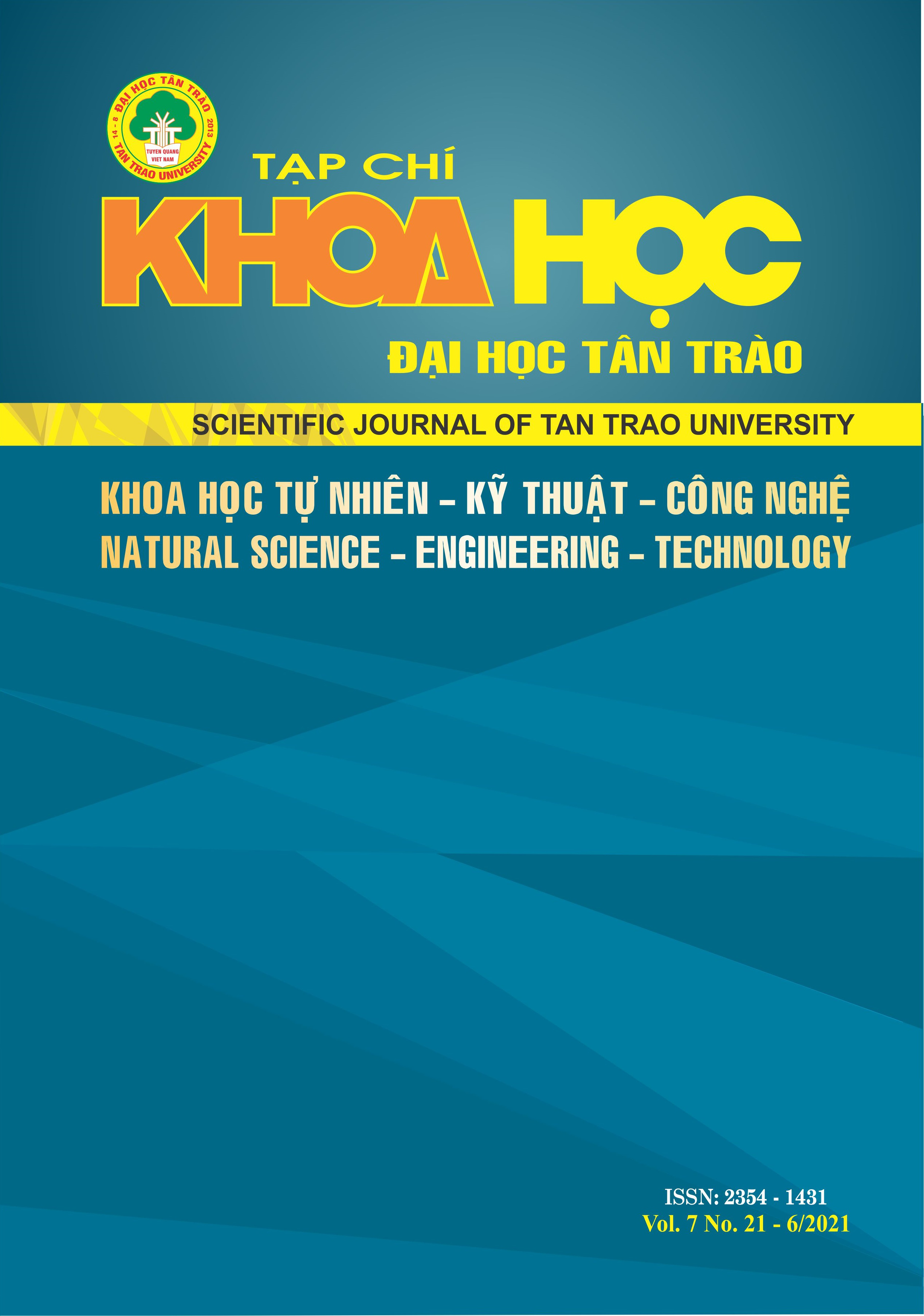PLASMON PROPERTIES IN 3 - LAYER GRAPHENE SYSTEMS AT ZERO TEMPERATURE
DOI:
https://doi.org/10.51453/2354-1431/2021/515Keywords:
inhomogeneous background dielectric; damping rate; plasmon excitations; three-layer graphene system.Abstract
Plasmon excitation is one of the important properties of a material and is applied in lots of technological fields. Plasmon excitations in graphene and graphene-based structures have been studied intensively in recent years. This paper uses a random-phase approximation to calculate plasmon excitations in a three-layer graphene system (consisting of a monolayer and a bilayer graphene sheet) at zero temperature. Calculations demonstrate the existence of three undamped plasmon modes in long-wavelength regions, but their damping rates differ significantly from each other in short-wavelength areas. The increase in separation leads to different changes in the frequency of collective modes. In addition, inhomogeneous background dielectric and the decrease in carrier density in bilayer graphene affect strongly plasmon frequencies.
Downloads
References
[1] Geim A.K., Novoselov, K.S. (2007). The rise of graphene, Nature Mater 6, 183.
[2] Maier, S.A.(2007). Plasmonics–Fundamentals and Applications. Springer, New York.
[3] McCann, E. (2011). Electronic Properties of Monolayer and Bilayer Graphene, In: Raza H. (ed.) Graphene Nanoelectronics. Berlin: NanoScience and Technology Springer.
[4] DasSarma, S., Adam, S., Hwang E.H., Rossi, E. (2011). Electronic transport in two dimensional graphene, Review Modern Physics 83, 407.
[5] DasSarma, S., Hwang E.H., Rossi, E. (2010). Theory of carrier transport in bilayer graphene. Physical Review B 81, 161407.
[6] Politano, A., Cupolillo, A., Profio, G.Di., Arafat, H.A., Chiarello, G., Curcio, E. (2016). When plasmonics meets membrane technology, J. Phys. Condens. Matter 28, 363003.
[7] Politano, A., Pietro, A., Profio, G.Di., Sanna, V., Cupolillo, A., Chakraborty, S., Arafat H., Curcio, E. (2017). Photothermal membrane distillation for seawater desalination, Advanced Materials 29, 03504.
[8] Ryzhii, V., Ryzhii, M., Mitin, V., Shur, M.S., Satou, A., Otsuji, T. (2013). Injection terahertz laser using the resonant inter-layer radiative transitions in double-graphene-layer structure, J. Appl. Phys. 113, 174506.
[9] Shin, J.S., Kim, J.S., Kim, J.T. (2015). Graphene-based hybrid plasmonic modulator, J. Opt. 17, 125801.
[10] Yan, H., Li, X., Chandra, B., Tulevski, G., Wu, Y., Freitag, M., Zhu, W., Avouris P., Xia, F. (2012). Tunable infrared plasmonic devices using graphene/insulator stacks, Nature Nanotech. 7, 330.
[11] Hwang E.H., DasSarma, S. (2007). Dielectric function, screening, and plasmons in 2D graphene, Physical Review B 75, 205418.
[12] Sensarma, R., Hwang E.H., DasSarma, S. (2010). Dynamic screening and low energy collective modes in bilayer graphene, Physical Review B 82, 195428.
[13] Badalyan S.M., Peeters, F.M. (2012). Effect of nonhomogenous dielectric background on the plasmon modes in graphene double-layer structures at finite temperatures, Physical Review 85(19), 195444.
[14] Khanh, N.Q., Men, N.V. (2018). Plasmon Modes in Bilayer–Monolayer Graphene Heterostructures, Physica Status Solidi B 255(7), 1700656, Vietnam.
[15] Men, N.V., Khanh, N.Q. (2017). Plasmon modes in graphene–GaAs heterostructures, Physics Letters A 381(44), 3779, Vietnam.
[16] Principi, A., Carrega, M., Asgari, R., Pellegrini V., Polini, M. (2012). Plasmons and Coulomb drag in Dirac/Schrodinger hybrid electron systems, Physical Review B 86, 085421.
[17] Scharf B., Matos-Abiague, A. (2012). Coulomb drag between massless and massive fermions, Physical Review B 86, 115425.
[18] Hwang E.H., DasSarma, S. (2009). Exotic plasmon modes of double layer graphene, Physical Review B 80, 205405.
[19] Vazifehshenas, T., Amlaki, T., Farmanbar M., Parhizgar, F. (2010). Temperature effect on plasmon dispersions in double-layer graphene systems, Physics Letters A 374(48), 4899.
[20] Zhu, J.J., Badalyan S.M., Peeters, F.M. (2013). Plasmonic excitations in Coulomb-coupled N-layer graphene structures, Physical Review B 87, 085401.
[21] Men, N.V. (2020). Plasmon modes in N-layer gapped graphene, Physica B 578, 411876, Vietnam.
[22] Phuong, D.T.K., Men, N.V. (2019). Plasmon modes in 3-layer graphene structures: Inhomogeneity effects, Physics Letters A 383, 125971, Vietnam.
[23] Men, N.V., Khanh, N.Q., Phuong, D.T.K. (2019). Plasmon modes in N-layer bilayer graphene structures. Solid State Communications 298, 113647, Vietnam.
[24] Wachsmuth, P., Hambach, R., Benner G., Kaiser, U. (2014). Plasmon bands in multilayer graphene, Physical Review B 90, 235434.
[25] Phuong, D.T.K., Men, N.V. (2020). Plasmon modes in N layer graphene structures at zero temperature, Journal of Low Temperature Physics 201: 311–320, Vietnam.
[26] Svintsov, D., Vyurkov, V., Ryzhii, V., Otsuji, T. (2013). Voltage-controlled surface plasmon-polaritons in double graphene layer structures, Journal of Applied Physics 113, 053701.
Downloads
Published
How to Cite
Issue
Section
License

This work is licensed under a Creative Commons Attribution-ShareAlike 4.0 International License.
All articles published in SJTTU are licensed under a Creative Commons Attribution-ShareAlike 4.0 International (CC BY-SA) license. This means anyone is free to copy, transform, or redistribute articles for any lawful purpose in any medium, provided they give appropriate attribution to the original author(s) and SJTTU, link to the license, indicate if changes were made, and redistribute any derivative work under the same license.
Copyright on articles is retained by the respective author(s), without restrictions. A non-exclusive license is granted to SJTTU to publish the article and identify itself as its original publisher, along with the commercial right to include the article in a hardcopy issue for sale to libraries and individuals.
Although the conditions of the CC BY-SA license don't apply to authors (as the copyright holder of your article, you have no restrictions on your rights), by submitting to SJTTU, authors recognize the rights of readers, and must grant any third party the right to use their article to the extent provided by the license.


